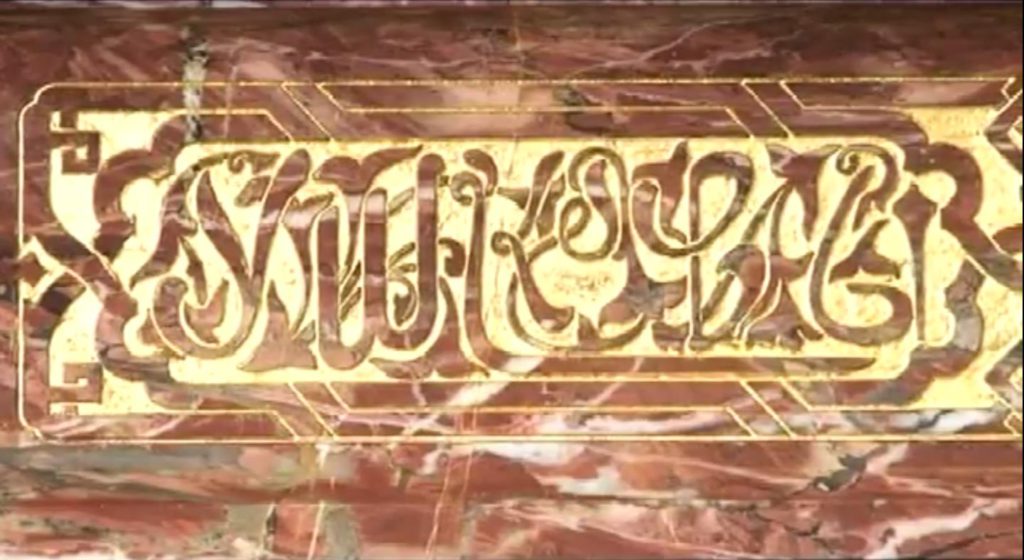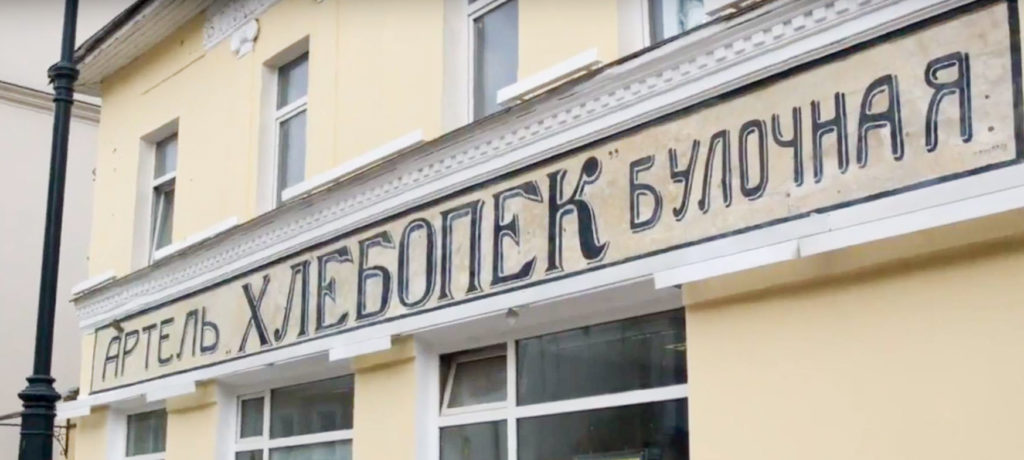From “Loafer” to the Ministry of Foreign Affairs
In the header of Russian version of the post the word Loafer (idler)” (in Russian — лодырь, could be transcripted like LODYR) is used. The point is that the Russian idiom “Goniat lodyria” (“гонять лодыря”) actually (let say, word by word) closely means “chasing a loafer ” and really corresponds to English idiom “being a lazy bum” (perhaps, «chasing a loafer»). But here in Russian version of the post there is a “play” of two words “Lodyr” (loafer, idler) and last mane — Christian Loder mentioned below.
At the very end of 1999, the restoration of the mansion at Prechistenka 20, was officially completed. The mansion at various times was owned by (lived here) a number of very remarkable for our history of personalities .
During the restoration work, the interior of the Moorish room, which was considered to be missing, was attributed to the author of Fyodor Osipovich Shekhtel. An amazing design of the fireplace was discovered and uncovered under 12 layers of white paint. Like the whole room, this fireplace decoration was stylized under the Samarkand mausoleum from the Shah-i-Zinda complex, including the characteristic Arabic script
But on closer examination of this «Arabian ligature» you can actually discover our native (at the beginning of the 20th century — with the symbol «Ѣ») the inscription of the last legal owner of this mansion — Ushkov.
Fedor Osipovich Shekhtel demonstrated here his amazing talent in such seemingly small things, saving for the descendants the name of the owner «weaving» it into the Arabian ligature!
The Moorish hall itself, which according to some sources was originally designed as a smoking room, now serves as the official reception hall of the Main Directorate of the Russian Ministry of Foreign Affairs, who now considers himself the owner of this mansion. Unfortunately, photos of this object of cultural heritage of the federal significance (more precisely, its interiors) are practically absent, and the possibility of visiting it, as it is stipulated by Federal Law No. 73-FZ of June 25, 2002, also seems very doubtful. So, either «responsible» «comrades» or representatives of the diplomatic corps only can familiarize themselves with this cultural heritage of the peoples of Russia.
This mansion got its present look in 1907 (1909?) when its last lawful owner Alexei Konstantinovich Ushkov ordered the reconstruction of the property, built earlier, in the early 19th century in the classical style.
The authorship of the mansion acquired by Ushkov is attributed to Matvei Kazakov, but no documentary evidence has been found. To establish the architectural authorship of the building that was reconstructed for Ushkov and has survived to our days, small journey in space and in time will be required — at the very beginning of the 20th century, in …. Kazan.
«I want the whole world to fit in my house. Decorate each room in a separate style. » This is how Alexei Konstantinovich Ushkov responded to the question of architect Karl Ludwigovich Mufke, in which style he would like to rebuild the property along Voskresenskaya Street (now Kremlyovskaya, 33) in Kazan.
Alexei Ushkov (1879-1948) came from the wealthy industrialists Ushkovs who founded in the middle of the 19th century in the then village of Bondyuga — now it is the city of Mendejevsk, near the Yelabuga large chemical production. Now this is a chemical plant named after Karpov. On the maternal line Alexei Ushkov inherited the tea «empire» of Gubkin-Kuznetsov, including the tea plantations in Ceylon.
One can not help recalling the words of Dmitry Ivanovich Mendeleyev, who worked for several years at the plant of the Ushkovs in Bondyuga: «I, who saw a lot of West European chemical plants, were proud to see that what could be done in Russia not only does not concede, but in many respects surpasses the foreign …»
Being still a student of Kazan University, Aleksey Konstantinovich Ushkov for his wedding receives as a gift from his uncle several buildings located on Voskresenskaya Street in Kazan. Perhaps not without the participation of the bride’s father, Zinaida Vysotskaya, professor of surgical pathology at Kazan University, Nikolai Fyodorovich Vysotsky, architect Karl Myfke was invited. Exactly at that time he had designed and supervised the construction of Kazan University.
Alex Ushkov building, altered on the project of Mufke was presented as a gift to Ushkov’s bride in 1907 (1908?). Republican library of Tatarstan is placed here now and those who wish can easily make a virtual tour of its intricate interiors «that have placed the whole world».
But back to Moscow, to Prechistenka. Below there are photos of Ushkov’s building in Kazan and his building on Prechistenka. There are enough reasons to believe that these are practically «twin brothers»: a common composition, the richest and, with nothing comparable, decorative decoration, decoration of the balcony.
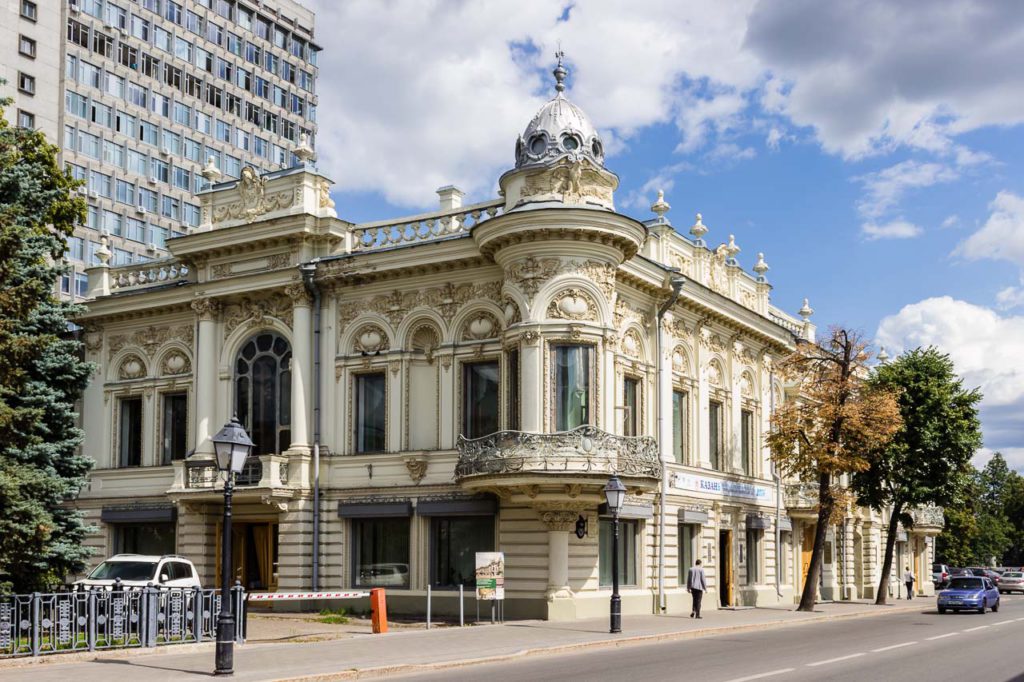 |
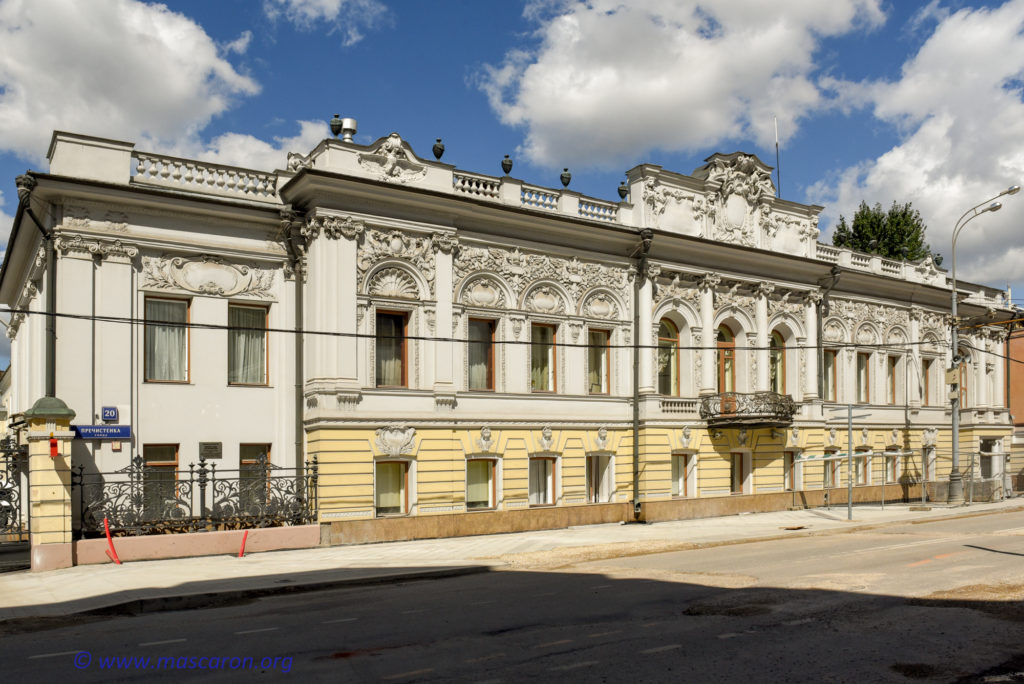 |
Ushkov’s Building in Kazan is located on the corner of two streets, has two «front» facades, in contrast to our Moscow building. But the general composition of the facades — two floors and their proportions, the first with rustic furniture, and the second with rich stucco decor and openwork, the characteristic shape of a forged balcony lattice, the decoration of the roof with vases, all this generally confirm the identity (possibly, processing) of projects.
A careful examination of the elements of the decor strengthens this position even more: on the facades of both buildings there are quite characteristic birds, an ornament with a caduceus, shells, lion’s faces, and a female head on a pediment. Very characteristic and almost coincident pair images of griffins:
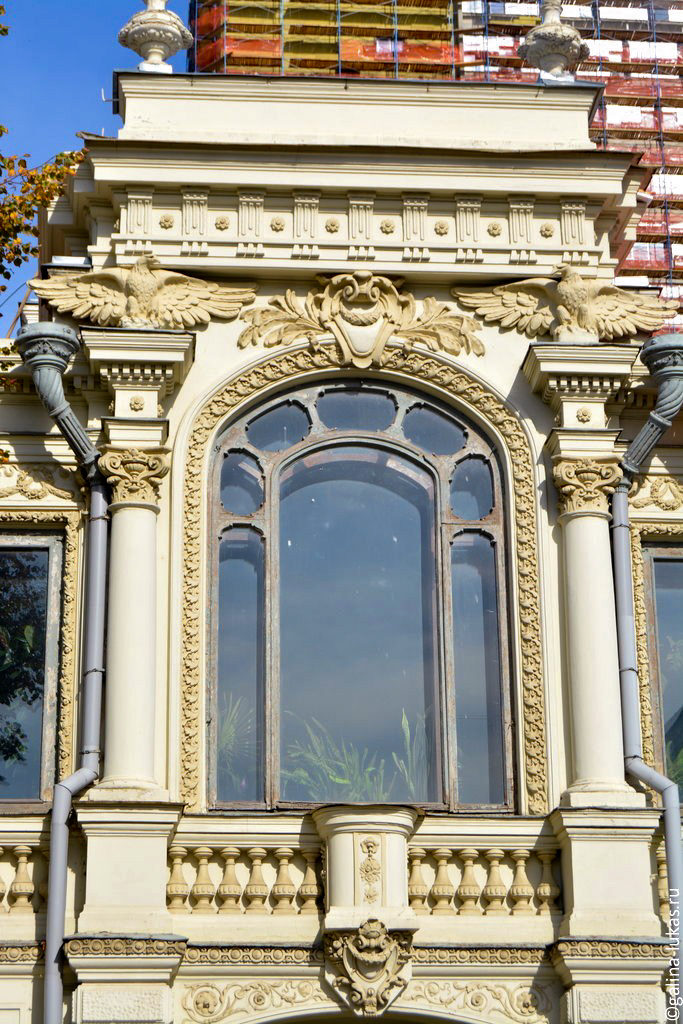 |
 |
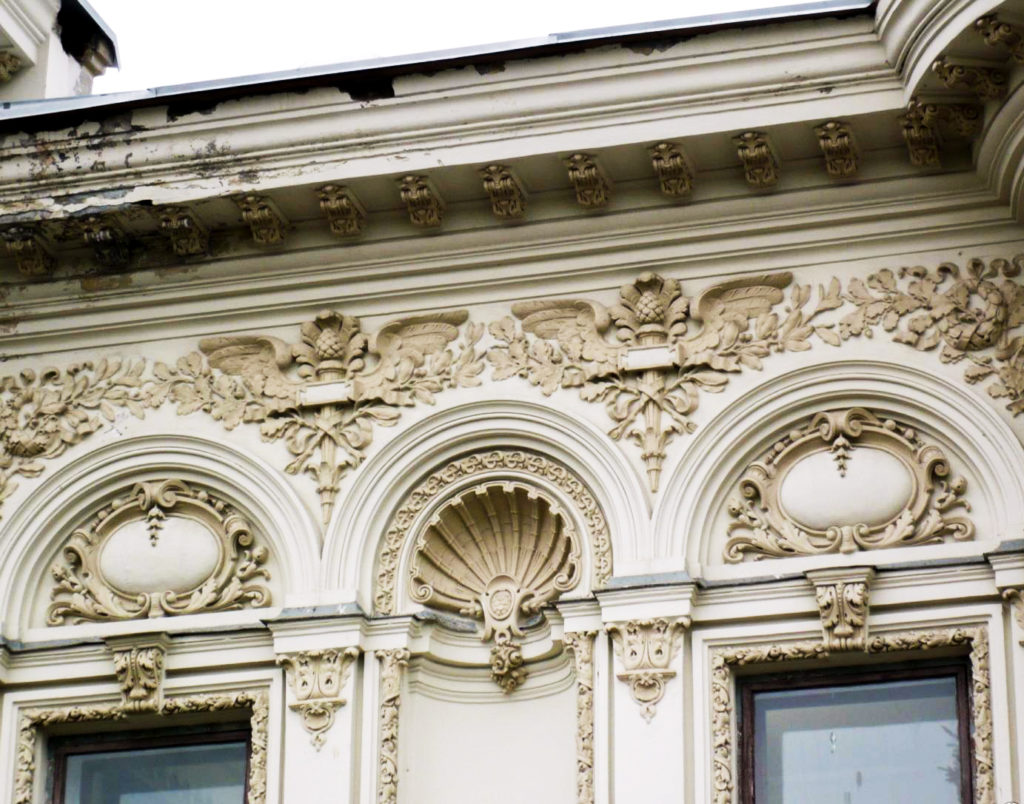 |
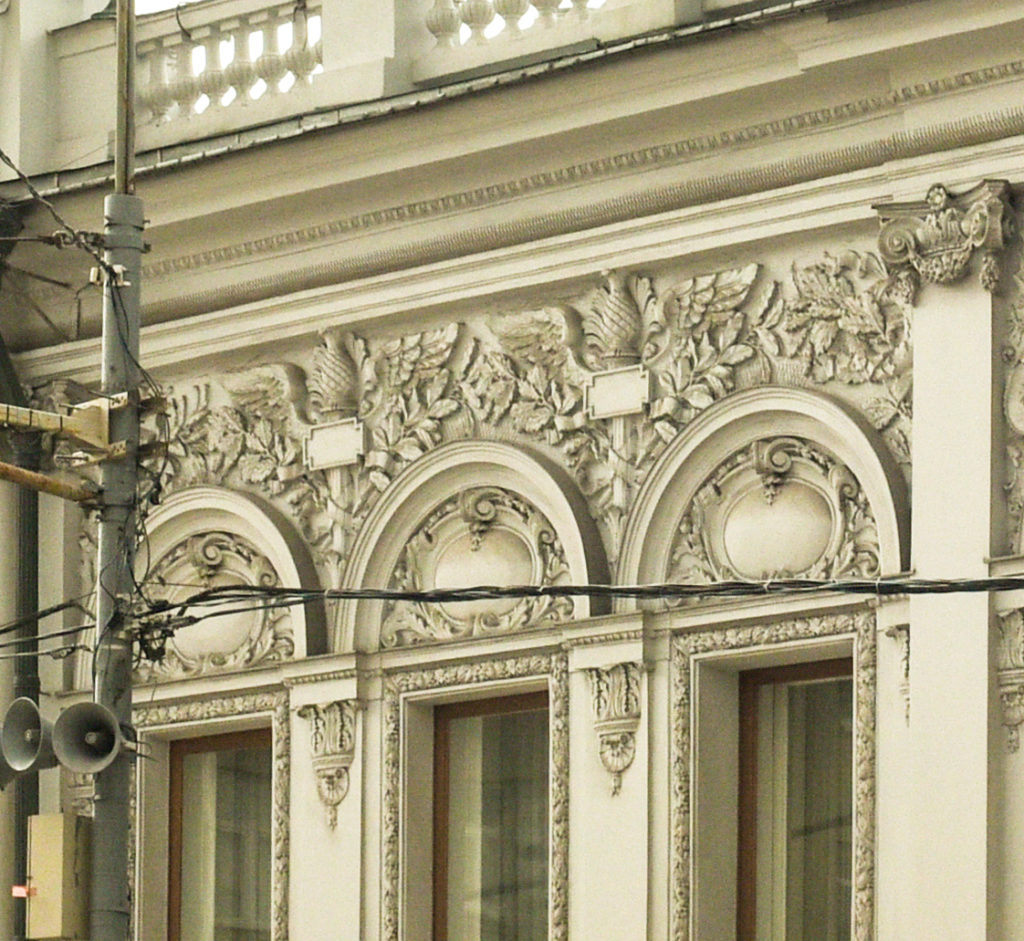 |
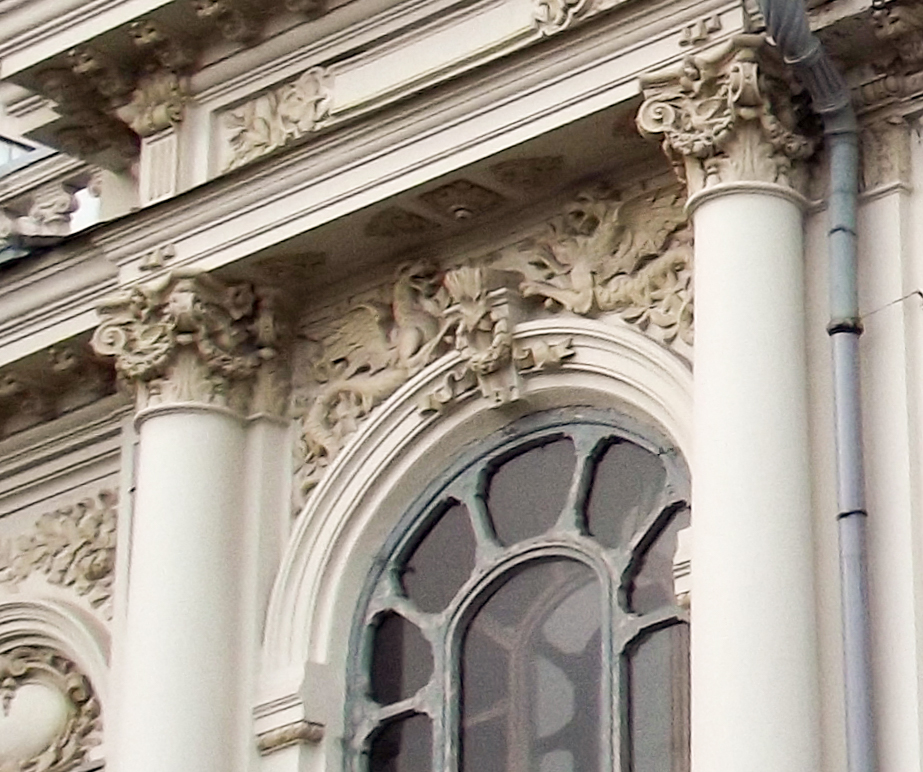 |
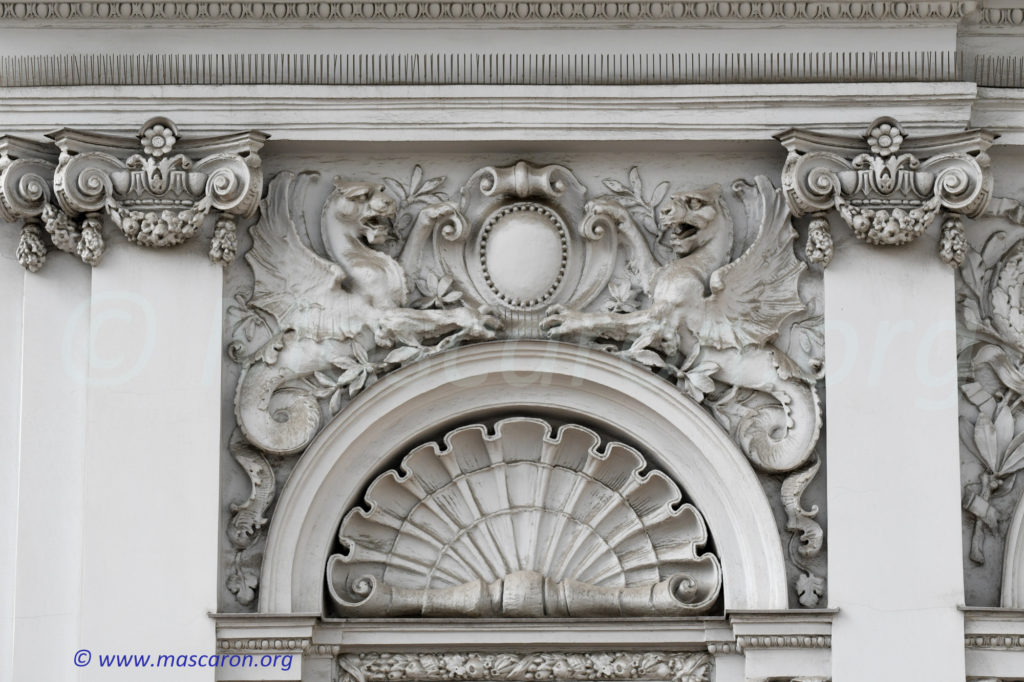 |
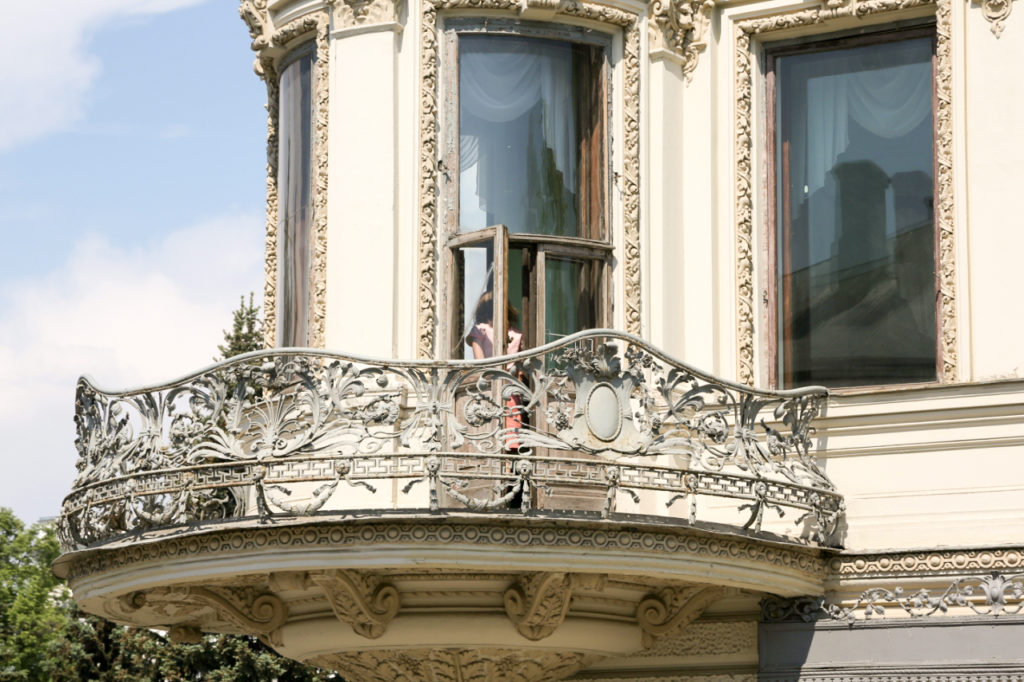 |
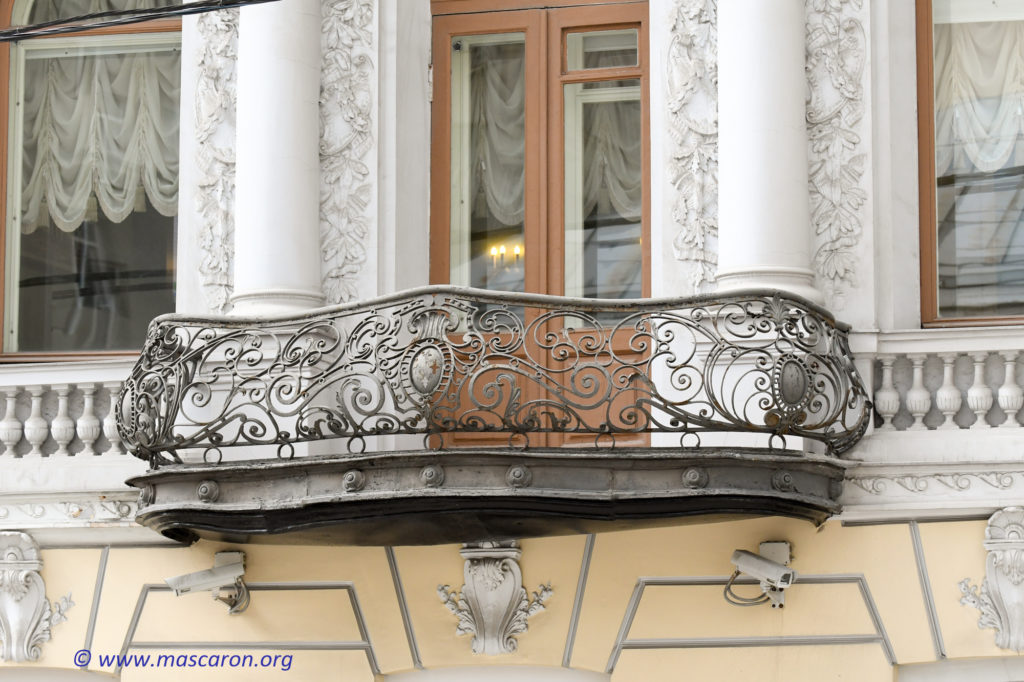 |
 |
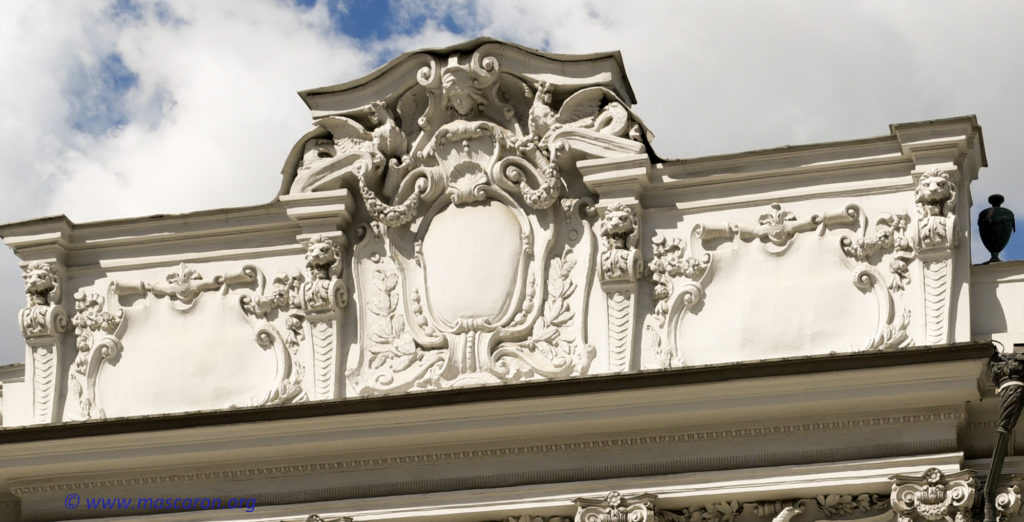 |
There is a documentary evidence of authorship and direct involvement of Karl Mufke in the construction of the Kazan mansion of Ushkov. “Kazan Telegraph” newspaper, in 1906 wrote: «Yesterday, at the construction site of Ushkov’s building, architect Mufke fell from the scaffolding …». Further it was reported that he broke two ribs, but «but he did not leave work and, having shaken himself off, courageously climbed on scaffolding.»
As for the construction of the Moscow building of Ushkov on Prechistenka (more precisely, the restructuring from the strictly classical Moscow mansion of the 19th century), it has not been possible to find exact evidence yet. However, the obvious stylistic similarity makes it possible, with a sufficient degree of certainty, to attribute the authorship of the project itself to Karl Mufka.
But to decorate the interior, in particular, the smoking room in the oriental style, Fedor Shekhtel, was invited. Architect Shekhtel already well acquainted with Ushkov’s older brother Grigory Konstantinovich, to his Moscow mansion (Rozhdestvensky Boulevard house 10). By the way, it is worth recalling that Shekhtel built the wine cellar for Gregory Konstantinovich Ushkov in Foros (based on the wine cellars in Shimpan). This cellar «Six beams», being buried to 8 meters, provided a constant temperature of 12-13 ° C and contained up to 100 thousand buckets of wine. (For reference: in the publication » Architects of the Moscow Art Nouveau. Creative portraits “ M. Nashchokina does not mentioned in the list of works by Fyodor Shekhtel interior design in the house of Alexei Ushkov on Prechistenka)
But to decorate the interior, in particular, the smoking room in the oriental style, Fedor Shekhtel, was invited. Architect Shekhtel already well acquainted with Ushkov’s older brother Grigory Konstantinovich due to his Moscow mansion (Rozhdestvensky Boulevard house 10). By the way, it is worth recalling that Shekhtel built the wine cellar for Gregory Konstantinovich Ushkov in Foros (based on the wine cellars in Champagne). This cellar «Six beams», being buried to 8 meters, provided a constant temperature of 12-13 ° C and contained up to 100 thousand buckets of wine. (For reference: in the publication «M. Nashchokina does not indicate in the list of works by Fyodor Shekhtel interior design in the building of Alexei Ushkov on Prechistenka)
Due to the second marriage of Alexei Konstantinovich his building on Prechistenka 20 literally a few years after its construction underwent a remarkable internal reconstruction. Most likely, it was this reorganization that played a very significant role in its subsequent destiny. Aleksei Konstantinovich was the second marriage to a well-known ballerina of the Bolshoi Theater Alexandra Balashova, and rehearsal room with mirrored walls (ballet rehearsal room) was created for her in the mansion.
Ilya Ilyich Schneider who began his career as a journalist and theater reviewer in 1912 recalled this hall and the splendid decoration of the internal living quarter. Soon after the February of 1917, after a charity ball at the Bolshoi Theater, he happened to accompanied Balashov to her home. Alexandra Mikhailovna invited him to come in and conducted an «excursion» through her chambers, which literally several years later Schneider would remember, but in connection with another mistress of the mansion on Prechistenka Street.
In 1921 Alexei Ushkov and Alexander Balashov left their mansion and soon settled in Paris at Rue de La Pampe, 103 in a house once owned by Isadora Duncan another famous dancer. And in the same year, 1921, it was Ilya Schneider who, on behalf of Lunacharsky, became Isadora’s secretary Duncan, accompanies Isadora to her new Moscow house with …. ballet rehearsal room on Prechistenka 20.
In his book “Meetings with Esenin” (Moscow: Soviet Russia, 1974), he recalls: «This house was given to the Moscow school of Isadora Duncan. In the same place we lived. I remember how later I saw Isadora once standing silently on the white marble staircase of the mansion. She looked from underfoot at Balashov’s ceiling beauties, a marble balustrade dotted with the golden molding of a column of rosewood … Then she said:
«I said for a long time ago that you need to tear off all this gilding along with the Romans and Greek womens and bleach everything!»
And here’s how Schneider describes the first visit to Duncan of Ushkov’ & Balashova’s mansion-:
«Entering for the first time into the mansion, Duncan twisted her lips at the sight of ceiling beauties, gold-stuck colonies and bronze bas-reliefs. In her room, Isadora sank into a chair and burst into irrepressible laughter:
— Quadrille! — she screamed, laughing contagiously. — Changez vos places! »
It is necessary to explain that the unsuccessful translation of the expression ,”Changez vos place” as a quadrille,and it was then replicated many times in connection with this story, having lost the «hidden meaning». Changez vos places — literally means «Change your places!» This is what the dance manager says in one of the quadrille figures at the dance balls. And that’s exactly what Isadora Duncan reacted to in a peculiar way … .not about partners in the dance at the ball, and houses for living in the invisible «dance» of life in partnership with Alexandra Balashova!
Sergey Yesenin lived for several years with Isadora Duncan On Prechistenka 20. Ilya Schneider was unintelligible witness of their introduction. This very first meeting took place at the literary and art party of Gregory Yakulov the artist-avant-garde artist (Georges the Beautiful) in the artist’s studio located in the house at No. 10 in Bolshaya Sadovaya — the famous Bulgakov’s House! Amazing coincidences of noteworthy addresses, are not they?
Schneider remembers: «…… But on that first morning (after the literary party at Yakulov’s — note mascaron.org) neither Isadora nor Yesenin paid any attention to the fact that we already once again go around the church. The dozing cabby also did not notice this.
«Hey, father!» — I touched his shoulder. «Are you crowning us, or what?» Around the church, as around the analogue, the third time you go.
Yesenin woke up and, learning what was happening, laughed joyfully.
— To marry! — he swayed in laughter, hitting himself on his knees and looking with laughing eyes at Isadora.
She wanted to find out what had happened, and when I explained, she held out a happy smile:
— Manage … (Wedding (French).)
Finally, the cabman left Chistyi lane to Prechistenka and stopped at the entrance of our mansion.
Isadora and Yesenin stood on the sidewalk, but did not say goodbye.
Isadora looked at me with guilty eyes and begged, nodding at the door:
— Ilya Ilic … cha-ay (tea-a – note mascaron.org )?
«Tea, of course, can be arranged,» I said, and we all went into the house.
Like most journalists, Ilya Schneider is inclined to exaggerate, as well to invent «facts» — very few people will trouble themselves with an elementary check of facts and dates. Therefore, it’s remains only to believe Ilya Schneider, moreover that not any other participants in this equestrian route remembered him, neither Yesenin, nor Duncan, nor the cabman, nor his horse haven’t wrote theier recalls. The legend wrote by a professional literary journalist? Perhaps, but, one can not but admit, pretty … and already become, like a true Moscow story, many times replicated …
But the history of the house on Prechistenka 20 deserves attention not only in connection with his ballet and literary past. This house keeps memories not only of Alexander Balashova (who had great success in Paris) and Alexei Konstantinovich Ushkov, Isadora Duncan and Sergei Yesenin.
With great certainty it can be assumed that the Tretyakov brothers visited also the mansion at Prechistenka 20. The point is that the previous owner of this mansion, Vladimir Dmitrievich Konshin, was married to Elizaveta Mikhailovna Tretyakova, sister of Pavel and Sergei Tretyakov. Vladimir Dmitrievich Konshin (1824-1915) began his career as a clerk in the house of the father of the Tretyakov brothers, Mikhail Zakharievich. Possessing outstanding business qualities, helped him to jointed to Pavel and Sergey Tretyakov, and take part in the establishing of the company «Shop of Linen, Paper, Woolen Goods, Russian and Foreign Trade Houses of P. and S. of the Tretyakov brothers and V. Konshin in Moscow». And a few years later in 1866, Vladimir Konshin became chairman of the board of the company of the Linen Manufactory (Kostroma), the successor of the trading house «Peter and S. brothers Tretyakov and V. Konshin.»
The fabrics produced at the manufactory enjoyed a well-deserved recognition, they often received gold medals in Paris and Turin. The enterprise was the supplier of the Court of His Imperial Majesty. As the opening sources on the Web indicate, «it was the only factory in the world where 54 thousand spindles worked under one roof; it was created without any participation of foreigners. The turnover of the company reached an amount of 12 million rubles a year. »
Vladimir Dmitrievich Konshin was a vowel of the city duma and elected merchant society, was a notable benefactor, was personally acquainted with many artists and writers. And his daughter, married Anatoly Chaikoyevsky, the brother of the famous composer.
Returning to the building itself on Prichistenka, some sources suggest that Vladimir Dmitrievich Konshin invited the well-known architect Alexander Stepanovich Kaminsky, married to another sister of the Tretyakovs, Sophia, to take take charge of the construction of the residence.
An interesting coincidence: the history of one more kind of Konshins is connected with Prechistenka — the famous Moscow House of Scientists (Prechistenka 16) was built for Alexandra Ivanovna Konshina (http://mascaron.org/2016/10/28/205/ But these namesakes, originally from Serpukhov.
The page of the history of the residence that preceded Konshin is connected with the military victories and conquests of Russia. General Ermolov — the hero of Borodino, who beat off the Rayevsky battery of the Frenchmen, the conqueror of the Caucasus, who in fact founded such fortresses as Nalchik, Sudden and Terrible! It is with this extraordinary man that the earlier (first half of the 19th century) house history on the Prechistenka 20 is connected.
After retiring in 1827, the legendary general several years spent on his estate near Orel, where he was visited by Pushkin. After Emperor’s prohibition to go abroad, Ermolov moves to Moscow, where he acquires this particular mansion on Prechistenka 20. In this house, General Ermolov and remained for the rest of his days. During the Crimean company from 1853 he headed until 1855 the Moscow militia, whose actual headquarters was his house on Prechistenka. In 1861, Moscow saw off the general in his last journey for two days. By the way, despite the completely ambiguous attitude to the General of the Imperial dynasty (his views and relations with the Decembrists were not forgotten), in St. Petersburg in memory of General Ermolov on Nevsky Prospect, his portraits were displayed in all stores. Under the will of General Ermolov, he was buried in his native Orlovschine. In Orel was arranged a grand funeral service: and the square in front of the Trinity Church, where the funeral service was held, and all the surrounding streets were completely filled with those who came to bid farewell to the General.
Griboyedov, who served at one time under the command of General Ermolov in Tiflis, called him «the Sphinx of modern times.» So, passing through Prechistenka past house 20, it is worth remembering these glorious villages of Russian history and even mentally paying tribute to General Ermolov, who served more like for Fatherland than for it’s Emperors! A worthy example, prompting much to think about now, at this time!
Moving on the scale of time closer to the beginning of 19 and further the story of the building of 20 on Prechistenka increasingly loses the documents, about its owners, but instead replaces the lost with legends, possibly connected with real events and this very possession.
Thus, the Moscow tradition ascribes to this house the story of Countess Orlova, a domestic «joke» who, from the garden through the fence of the mansion, «communicate» with those passing by, was even once seen by Emperor Alexander I
But a much more «serious» legend even found its «place» in our days is connected with the doctor of medicine Justus Christian Loder, in Russia called as Christian Ivanovich Loder (1753-1832). Documentary evidence can not be found, but almost all sources indicate that it was probably at the very beginning of the 19th century that Christian Loder owned the possession on Prechistenka 20.
Having been educated in Riga, Justus Christian Loder gave a lectures and practiced in Jena, where he became the medical officer of the Duke of Saxe-Weimar. In 1803, Dr. Loder enters the service in Prussian Halle, where he becomes professor of anatomy. After the conquest of Galle by Napoleon’s troops, he moved to Koenigsberg, where he received in 1809 a diploma for the nobility. However, due to the political developments, already 1810, Christian Loder leaves the Prussian service and moves to St. Petersburg, where he is represented to the Emperor Alexander I. He practices in both Capitals — in St. Petersburg and Moscow. Christian Ivanovich Loder, being an outstanding personality, had close friendly relations with W. Goethe, F. Schiller, A. Humboldt.
Presumably it was Matvei Kazakov (?) who built before the Moscow fire of 1812 possession on Prechitenka 20, and doctor Loder moves into this location.
During the war of 1812, Christian Ivanovich Loder was engaged in the creation of hospitals for the wounded (for 6000 officers and 30,000 lower ranks). he was awarded the Order of St. Anna 2 nd degree with diamonds at rescript for this work.
In 1818, the sovereign bought from Loder his collection of anatomical preparations for the Moscow University. Dr. Loder himself was engaged in the re-creation of the anatomical theater plan he had developed in Moscow, which he spent about 100,000 (?) rubles. For this building he was awarded the Order of St. Vladimir 2-nd st.
Doctor of Medicine and Surgery (1777). Doctor of Philosophy Christian Ivanovich Loder is perpetuated as an honorary member of the Moscow University, as evidenced by the record in the Annals of the Moscow University.
But the history of the Moscow legends holds another episode associated with Dr. Loder. In November 1825, H. I. Loder prepared a report «On the preparation of artificial mineral waters by the method of Dr. Struve in Dresden and the project for the establishment of similar waters in Moscow», which was published in the printing house of the Moscow University. The report also outlined the «Draft plan for an alleged institution in Moscow with the permission of the Ministry of Internal Affairs to make artificial mineral water, according to Dr. Struve’s method, both for internal use and for making different baths.»
The companion of Dr. Loder was Professor of Chemistry of the Moscow University Fedor Fedorovich (Ferdinand-Friedrich) Reiss. A few years earlier F.F. Reiss investigated the composition of the mineral waters of the Caucasus, Tver and Moscow Gubernias, and opened a resort of mineral artificial waters in Neskuchny Garden. But the institution was not a success.
And the opened by the companions «Artificial Water Station» in Khilkov Lane on a slope that descended to the Moscow River not far from the present Crimean Bridge became unprecedented. Unlike the unsuccessful experience in the Neskuchny Garden, in the new institution, in addition to the mineral waters themselves, they practiced «wellness» procedures — unhurried, to the sounds of the orchestra 2-h or 3-hour walks, it is better to say — a walk through the picturesque (at that time) park alleys of the manor in Khilkov Lane.
The institution was arranged in a popular European manner, and the popularity of Dr. Loder himself played no small role. Philip Philipovich Vigel (1828), the well-known Russian memoirist, wrote about Dr. Loder institution: «The old and famous Loder started the first artificial mineral waters in Russia, they were just opened over the Moskva River, near the Crimean ford, in a lane, in the a large house with two attached galleries and a garden. Every day early in the morning I walked on foot along the Sraroy Konushennoy street to Ostozhenka street. Movement, the blessed morning air, clattering music and cheerful crowds of walking patients (of which two-thirds were healthy), dispelling gloom I was reveling in morality no less than the Marienbad water, which I reveled in. Novelty, fashion usually attracts an idle Moscow society, as a strong movement of air all drives it to one thing. This is why this new institution has become one of its places of entertainment » .
The rumor ascribes that it was here that the coachmen who were waiting for their masters answered numerous simple passers-by to the questions that they were “being a lazy bum” ( «chasing a loafer». Some «hot» heads are credited with even the very origin of the word “Lodyr” (please see above explanation about Russian idiom in spot head) of the name of the doctor — Loder. But this is not so, the word occurs, as Max Maxmer’s dictionary says, most likely from one of the dialects of the German language. The word Lodder (loder), which came to the Russian land supposedly with the Petrovsky reforms literally meant «scoundrel, scoundrel». But the expression «Drive a loafer,» it’s certainly our, native, and back to translate this expression into German is already difficult! Now, really, «Great and mighty ….»!
Returning to our days, it should be sying a few more words about the restoration work in house 20 in Prechistenka. According to the restorers, «surprises began when they began to work with the ceiling: it was found that it was filigree, boardwalk. The boards were removed and the remnants of the dome and traces of the knocked down plentiful moldings were opened. Later, at the opening of the floor, two boxes were found out from under the shoes, to which someone carefully folded the remains of the knocked stucco molding, as a message to the descendants, who will not break, but build. Discoveries continued: under many layers of paint covering the doors, a complex ligature of carved ornament was found, covered with gold leaf. The fireplace turned out to be marble, decorated with carvings on the stone, also gilded. Among the ornate ornaments, several ornate Arabic inscriptions were seen. » This is how the chief architect of the project for the reconstruction of the Mauritanian Hall, Galina Medvedeva, an employee of the Institute «Spetsproektrestavratsiya» about working in the Moorish hall of Shekhtel «… This is his early work — so to speak,» pre-modern «, but with a print of modernity. Paints are characteristic for the beginning of the century — as if muffled, this effect was achieved by a combination of oil paints and wax. And the very range of colors in the «Moorish hall» is surprisingly elegant — the colors are cherry, pink, ocher, turquoise, blue-green plus gold and bronze. This noble set of flowers, characteristic of modernity, was forgotten in the Soviet era, who knew for decoration of interiors only two colors — white and green. Fragments of the old paint, preserved on the remains of the stucco, we studied under a microscope. Surprisingly, among the two thousand colors proposed by modern firms, the necessary shades
It would seem that there is only one Moscow address, but how much he keeps with himself memories and legends, glorious pages of Russian history and its heroes.
At the end of August 2017, opposite the House 20 on Prechistenka, the inscription «Artel» KHLEBOPERK» Bulochnaya» was opened (under the layers of late painting). This signboard was probably also seen by Iscedorа Duncan and Sergei Yesenin. But the restoration of this signboard wasn’t conducted by GlavUpDK, but solely by the enthusiast-restorers — the public organization Trudcommuna (labour communa ) «Remember All». These works on the restoration of the Moscow signboards are made exclusively with the support of not indifferent Muscovites, and the public movement Arhnadzor.
